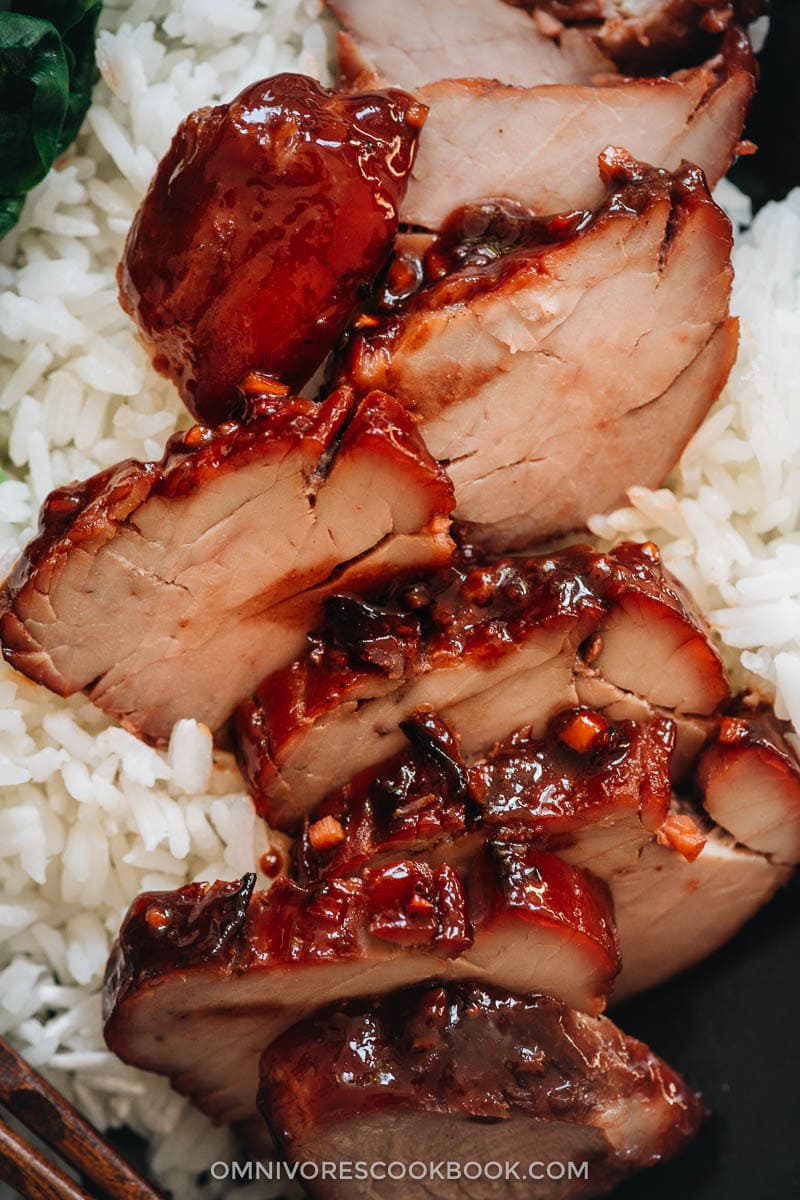
Hailing from Guangdong province in the south of China, char siu or barbecued pork is one of the darlings of dim sum, firmly in the catalog of Cantonese cuisine.
It doesn’t do the dish justice, merely to describe char siu with words. But it is a lean cut of barbecued pork, given a deep red color and shiny coating from the glaze. And it’s famously sweet. However, simply calling it sweet does not convey the complex flavors that result from the long marinating process.
The name Char Siu (or Cha Shao), literally means ‘fork roast’ due to the traditional way of cooking. After marinating, the pork is hung on a special fork and placed in the oven for roasting. During the roasting, the chef will baste the pork with a sugary glaze many times, giving it that appetizing glossy look.
A good char siu should be slightly chewy, juicy, with a vibrant, rich color and an equally alluring aroma. There are so many char siu recipes out there that simply yield a sweet piece of pork. For me, it’s important to create a good marinade base to give the cut a fragrant taste, and add just enough sweetness to complete it. That’s why you will see a lot of fresh aromatics and maybe less sugar in this recipe.
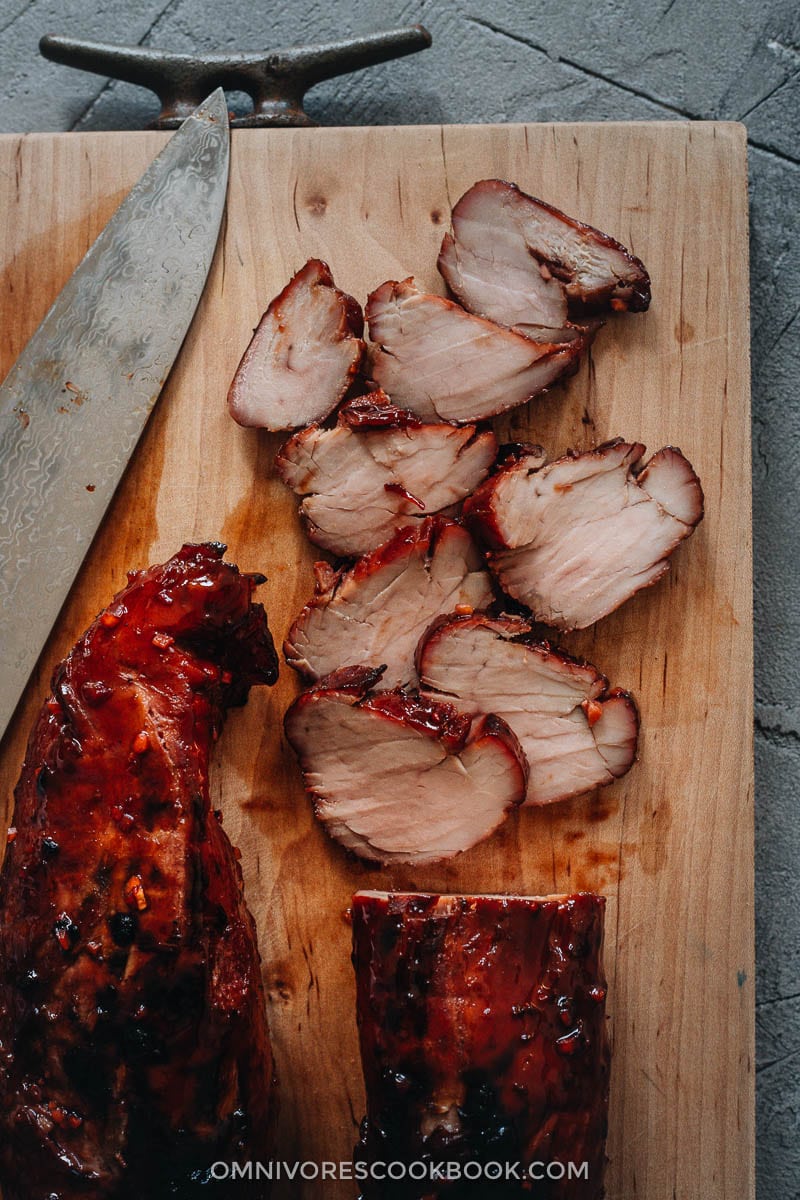
Cooking notes
1. Recipe update
The recipe was originally published three years ago. Over the years I’ve been trying to perfect the process. Today I’m sharing an updated version.
In this version I made a few small changes:
- Added molasses to the marinade to give the pork a better glaze.
- Reduced the soy sauce to create a thicker sauce, so it hangs onto the pork during roasting.
- Used maltose so the pork will have a glossy look, like in Cantonese restaurants.
- Simplified the baking and basting process.
2. What cut of pork for Char Siu
In this recipe I used pork tenderloin which is the lean cut traditionally used in Cantonese restaurants. You can also use pork loin if you want a slightly cheaper cut. Some people enjoy Chinese BBQ pork made from a fattier cut, for example, pork leg, or even pork belly. You can adapt the recipe according to your preference.
No matter which cut you use, you should cut it into pieces about 2” (6 cm) wide and 1”(3 cm) thick, so the baking time will remain the same.
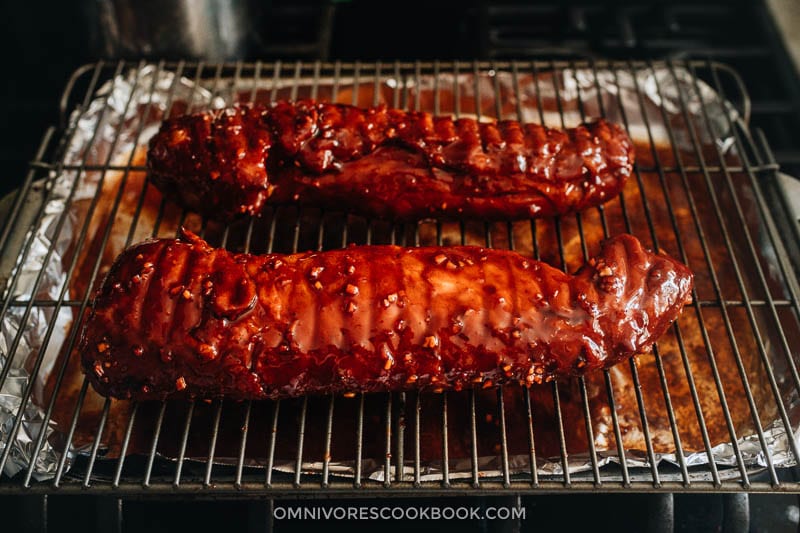
3. An introduction to Maltose
Maltose is a super thick syrup that’s commonly used in traditional Chinese cooking. It is the secret ingredient that gives the char siu its beautiful glossy look.
Maltose is made from rice and malt. At room temperature, it’s ten times thicker than your regular syrup. It won’t fall from the cup if you hold it upside down. If you dig your spoon into it, it will feel very tough and difficult to stir. It will become more runny once heated up, but still quite sticky. That’s why it gives the BBQ pork a better glaze that sticks to the surface.
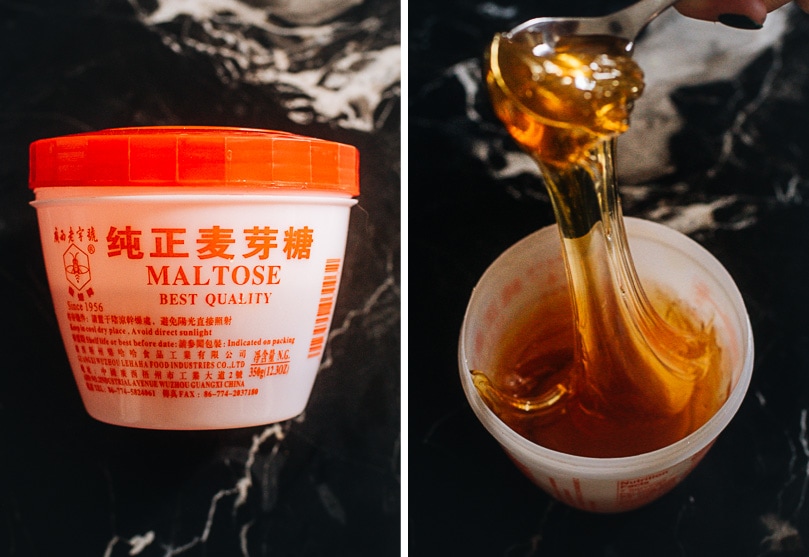
To use maltose, I usually microwave the jar for 20 seconds to get the surface softened. Otherwise it’s very hard to measure the correct amount. Once heated up, the sugar gets VERY HOT. Avoid touching the hot sugar with your hand.
A quick tip: coat your measuring spoon with a thin layer of oil before scooping out the maltose. The sugar will fall from the spoon much easier.
These days you can easily get maltose on Amazon, although you can also get a jar for less than two bucks at an Asian market.
If you don’t want to use maltose, you can use honey to replace it. The coating will not stick as well but it will still end up delicious.
4. Workflow
Making char siu is a two-step process. If you plan ahead and get organized, it’s quite simple to make.
(1) Mix the sauce and marinate one day before cooking
- You will use half of the sauce to marinate the pork. To give the pork as much flavor as possible, make sure to marinate it overnight.
- Cook the other half of the sauce with maltose. Store it in a jar to use for the glaze.

(2) Roast (or grill) the pork
- Set up your oven or heat up the grill.
- Brush the glaze over the pork multiple times while roasting (or grilling). To make the sauce stick better, use a brush to dab the glaze onto the pork.
- Cook until the pork reaches 165 degrees F (74 C) and is lightly charred on the surface.
- Rest the pork covered loosely with foil. Then brush on the final layer of glaze.
That’s it! Sounds pretty easy doesn’t it?
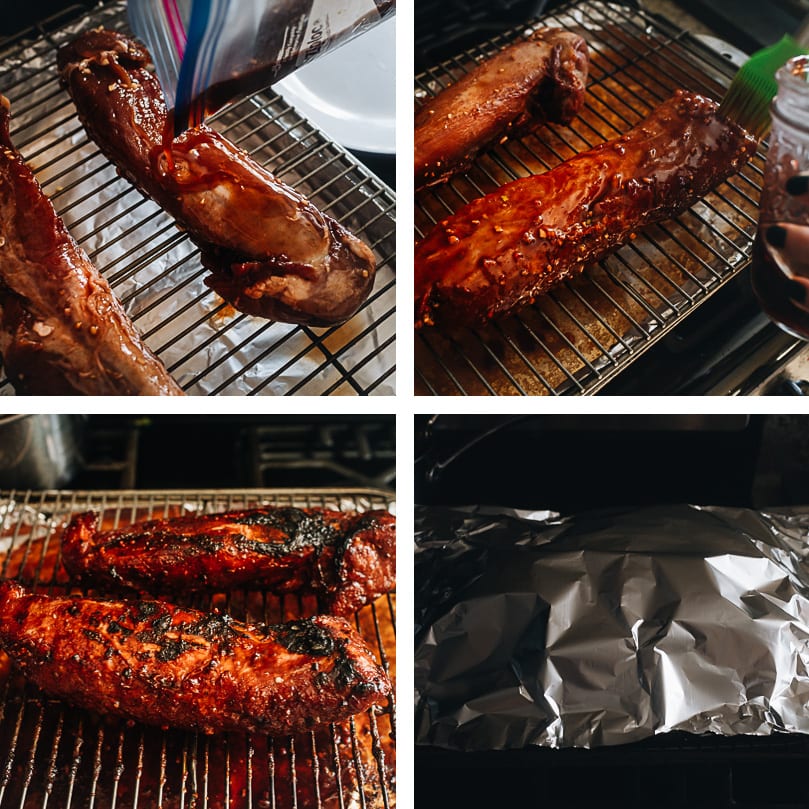

5. Leftovers
Here is the best part. Usually when you have leftovers, they are just waiting to be reheated and consumed the same way. Not with char siu!
If there is any leftover char siu, you can use it to make many popular dishes such as char siu pork lo mein, char siu fried rice, steamed char siu buns, baked char siu buns, wonton char siu noodle soup, and much more.
Afterthoughts
No matter whether you’re planning the menu for your next dim sum party or simply brainstorming for next week’s dinner, Chinese BBQ pork is a great choice. It is easy to prepare ahead of time. It tastes great served either fresh out of the oven or cold. And you can use the leftovers to create so many other delicious dishes.
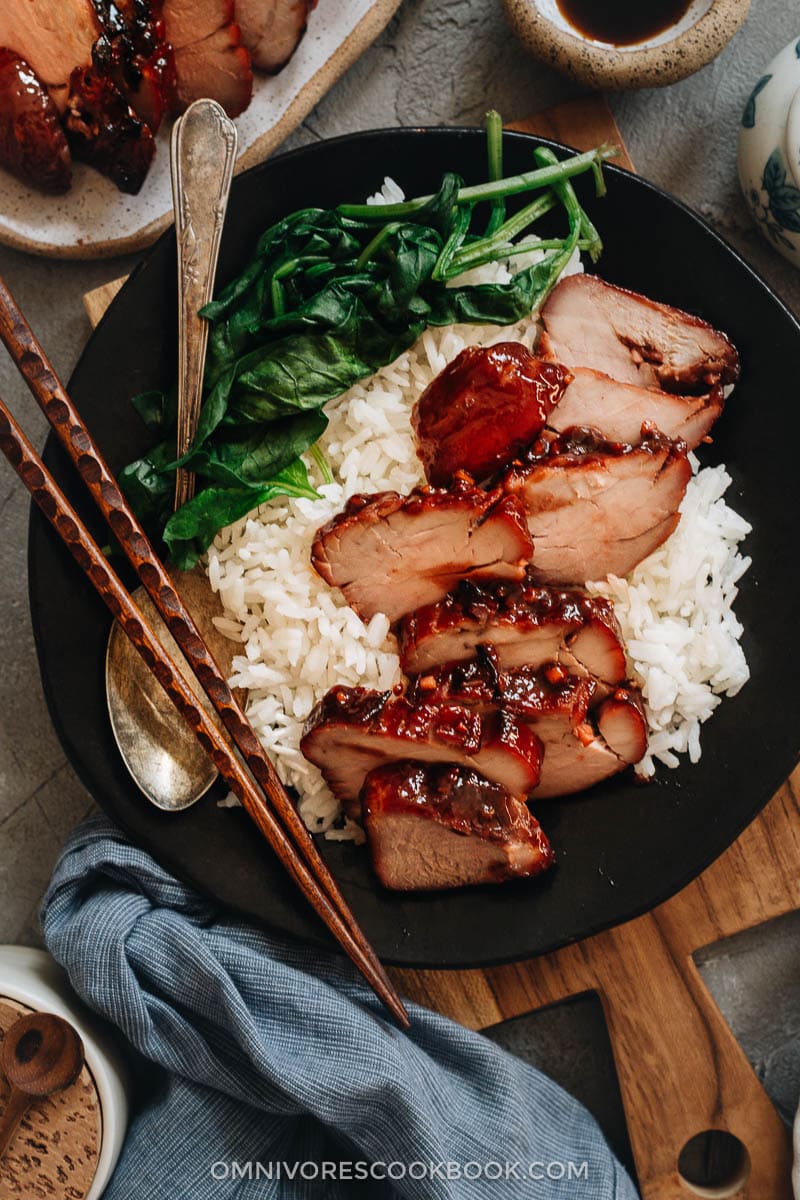
More delicious pork recipes
- Sweet and Sour Pork
- Chinese Lion’s Head Pork Meatballs
- Slow Roasted Crispy Pork Belly (Siu Yuk)
- Mom’s Best Braised Pork Ribs
- Asian-Style Instant Pot Pulled Pork
If you give this recipe a try, let us know! Leave a comment, rate it (once you’ve tried it), and take a picture and tag it @omnivorescookbook on Instagram! I’d love to see what you come up with.
Chinese Cooking Made Easy
Are you new to this website? This free email series is a great place to start. I’ll walk you through a few of my most popular recipes and show you how and why they work. You’ll quickly start to cook better Chinese food in your own kitchen.
Watch video
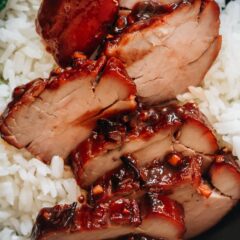
Char Siu (Chinese BBQ Pork, 叉烧肉)
Ingredients
- 2 to 2.5 lbs pork tenderloin (or pork loin)
Sauce
- 1/4 cup soy sauce
- 1/4 cup Shaoxing wine (or dry sherry)
- 1/4 cup hoisin sauce
- 1/4 cup oyster sauce
- 1/4 cup sugar
- 2 tablespoons molasses
- 2 teaspoon garlic , grated
- 1 teaspoon five spice powder
- 3/4 teaspoon salt
- 10 drops red food coloring (Optional)
- 2 tablespoons maltose (or honey)
Instructions
- (Optional) If you’re using pork loin, cut the pork along the grain, into 2 strips about 2” (6 cm) wide and 1”(3 cm) thick. Skip this step if using tenderloin.
- Prepare the marinade and the glaze the day before you cook.
Marinade
- In a large bowl combine the soy sauce, hoisin sauce, oyster sauce, Shaoxing wine, sugar, molasses, garlic, five spice powder, salt, and food coloring (if using). Stir to mix well.
- Transfer the pork into a large ziplock bag. Pour 1/2 cup of the mixed sauce into the bag. Squeeze out as much air as possible and seal the bag. Massage the bag a few times so the pork pieces are covered evenly with the sauce. Transfer to the fridge and marinate overnight (highly recommended), or for at least 6 hours.
Prepare the Glaze
- Microwave the maltose for 20 seconds or so, until the top loosens. Do NOT touch the maltose with your fingers. It’s very hot once it’s heated. Grease your tablespoon with a thin layer of oil. Transfer 2 tablespoons of maltose into a small saucepan. The oil coating on the spoon will help the maltose to fall into the pan without stuck on the spoon.
- Add the rest mixed sauce into the same pan. Heat over medium heat and stir frequently to melt the maltose, until brought to a simmer. Turn to medium low heat. Cook for 5 minutes to thicken the sauce slightly.
- Once done, let the sauce cool for at least 10 minutes. Carefully transfer the sauce into a heat-proof mason jar or container. Let cool for another 10 to 15 minutes. Cover and transfer into the fridge. The sauce will continue to thicken once chilled.
Roasting
- When the pork is marinated and the glaze is chilled, you’re ready to cook.
- Preheat the oven to 450 degrees F (230 C). Line a large baking tray with aluminum foil and add 1/4 inch (1/2 cm) water. Place a grilling rack on top. (Alternatively, you can grill the pork as well)
- Transfer the pork onto the grilling track. Drizzle a few tablespoons marinating liquid onto the pork. Bake for 10 minutes.
- Baste the pork, using a brush to dab the glaze onto the top side. Turn to the other side and dab glaze on top. Bake for 5 minutes.
- Baste the top of the pork, and bake for another 5 minutes. Once done, you can check the doneness by inserting a thermometer into the thickest part of the pork. It should read at least 145 F (63 C). Return the pork to the oven to bake for another 5 minutes or so if needed.
- Turn on the broiler. Broil for 3 minutes. Flip the pork to baste the other side. Broil for another 3 minutes. The pork should look glossy, lightly charred, and cooked through.
- Once the pork is done, brush it with the rest of the glaze. Cover loosely with aluminum foil. Let rest for 10 to 15 minutes before serving.
- You can serve the pork hot over rice as a main dish, or at room temperature as a cold appetizer. It’s super delicious either way.
Storage & other uses
- You can use the char siu drippings and meat to make char siu gravy (served with homemade scallion biscuits).
- You can use leftover char siu to make char siu fried noodles, char siu fried rice, and char siu buns (recipes coming soon!)
- To store the char siu, place it in a sealed container or bag and store it in the fridge for up to 4 days, or in the freezer for up to 1 month.
Nutrition

Did you make this recipe?
I’d love to hear how it turned out for you! Please take a moment to leave a 5-star rating ⭐️ and share your thoughts in the comments further down the page. It really helps others discover the recipe too.
Lilja Walter is a part of the Omnivore’s Cookbook team and worked closely with Maggie to develop and test this recipe.
The original recipe was published on Jan 25, 2016 and updated by Oct 16, 2019.

Stuart
AGAIN I’m making this recipe. It’s so yummy and seems very authentic. Tonight I’ll have it in a clay pot rice bowl with turkey, shrimp, veggies, and shoot for that crispy rice on the bottom.
Thank you Chef Zhu
Philip
made this with pork tenderloin. flavor was excellent but I think I overcooked it because it was dry. (Sometimes I think my Thermapen is broken 😒) I’m trying to not use the fattier cuts like pork butt so I’m wondering if a quick brine of the pork before adding it to the marinade my shield it a bit from drying out, or would it result in it being too salty? I’m willing to try it and report back
Ma
Wonderful
Vivian
Great recipe. I have made this several times and the family loves it.
Philip
DROOL!!!!🤤🤤🤤
Lillian
This came out sooo good! Even approved by my Chinese grandparents!
Jill S.
The search is over! This is my third attempt at make Char Siu and it was so yummy! The Hawaiian restaurant that sold me favorite Char Siu went out of business years ago and I’ve been on the search. Thank you for posting this recipe! The only change I made was using cooking sake instead of Shaoxing wine, I had all the ingredients in my pantry, which I love. Nothing too out of the ordinary like the other recipes I tried.
Alene
I looked up maltose and gluten free, and it appears that maltose itself is gluten free. But if it’s maltodextrin, that may not be. It also said that the wheat in it is so processed that people would not react to it. Is yours maltodextrin or just plain maltose? I am so confused, lol!
Maggie Zhu
The one I used was maltose, which is made from rice, malt, and water. It depends on what the malt is made from, but the product is very likely not gluten free. I think you will need to use honey instead for a gluten free dish.
Jierda
I love Char Sui and this recipe is easy to follow with an amazing result. Thank you Maggie.
Jon Sands
Can this recipe be applied to spareribs?
Maggie Zhu
I actually have a char siu rib recipe: https://omnivorescookbook.com/chinese-bbq-ribs/
I used Louisiana rbis but you can totally use spareribs. I think you’ll like this one 🙂
Colby
This was great served over rice! Thank you for sharing. I can’t wait to make fried rice with the leftovers!
Ivan
I want to make this, and I noted two different pork temperatures. In item 2, Roast the Pork, it says “at least 145 F (63 C) , yet on the recipe at the bottom, it says 165 F. Which is the target temperature?
Maggie Zhu
Hi Ivan, sorry for the confusion! In the recipe, the pork should reach 145 F (63 C) after you’ve done the oven roasting. Then it goes under the broiler, which should be finished at around 165 F. Your final target temperature is 165 F.
Yi Yi
I am such a huge fan of you and your website! My Chinese family never write down exact measurements or recipes, so I got to a stage in my adult life when I realised that if I wanted to eat delicious Chinese food whenever I wanted I needed to learn to cook it myself (LOL). Even my Dad reckons I can cook now 😉
KIM
⭐️⭐️⭐️⭐️⭐️Followed recipe exactly as written. I used pork loin. Came out perfect! Thank you for the detailed instructions along with a video- can’t make a mistake with this recipe!
robert f williams
Ms. Maggie. I was fortunate to find your web site. I bought your cook book and am a satisfied subscriber on your email list.
In addition to the Char Sui recipe, I noticed the Char Sui Bar 5 min 48 sec video. I have made no-pork (mushrooms/nuts) bun for years WOW Now I will use your recipe. Such beautiful video with clear easy to follow steps to make the buns. By taking your time you produced an award winning way to teach cooking. I will watch more in the future. One reason it is so delightful for me is the deliberate speed you show the recipe’s story with clear subtitles of ingredients. This is what is missing from many video cooking segments. I know you must have spent many hours to perfect this video….YOU GET THE GOLD OSCAR!
for best cooking video story. Finally you are so gracious to share your knowledge…THANK YOU.
And one hint…you are an attractive woman who needs to smile more and add to the charm you give us. RFW
Sue R
I accidentally boiled it all then used half as a marinade and half as a baste. It was fabulous! I used quite lean pork belly strips.
Sue
Will try this when I buy the ingredients love your step by step guide
J.HOLLANDS
excellent results and straight forward recipe.
Calista
Thank you for the recipe. My family love it.
Oscar
The recipes are great but your website is driving me crazy. I use an iPad and it keeps popping back to the top every time I turn around. Makes it very hard to read. Thanks for your homemade hoisin sauce I made some last night making charge to charge. Sure it’s ads constantly loading in popping up, That’s five times since I started type this. Thought it was the least I could do was tell somebody and thanks for that great recipe making the Char sui tonight